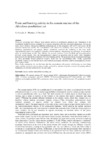Tonic and bursting activity in the cuneate nucleus of the chloralose-anesthetized cat

View/
Use this link to cite
http://hdl.handle.net/2183/14598Collections
- Investigación (FCS) [1293]
Metadata
Show full item recordTitle
Tonic and bursting activity in the cuneate nucleus of the chloralose-anesthetized catDate
1998Citation
Canedo A, Martínez L, Mariño J. Tonic and bursting activity in the cuneate nucleus of the chloralose-anesthetized cat. Neurosci. 1998;84(2):603-617.
Abstract
[Abstract] Whole-cell recordings were obtained from cuneate neurons in anesthetized, paralysed cats. Stimulation of the contralateral medial lemniscus permitted us to separate projection cells from presumed interneurons. Pericruciate motor cortex electrical stimulation inhibited postsynaptically all the projection cells (n=57) and excited all the presumed interneurons (n=29). The cuneothalamic cells showed an oscillatory and a tonic mode of activity. Membrane depolarization and primary afferent stimulation converted the oscillatory to the tonic mode. Hyperpolarizing current steps applied to projection neurons induced a depolarizing sag and bursts of conventional spikes in current-clamp records. This indicates the probable existence of low-threshold and hyperpolarization-activated inward currents. Also, the hyperpolarization induced on projection cells by motor cortex stimulation deinactivated a low-threshold conductance that led to bursting activity. The presumed cuneate interneurons had larger and more proximally located peripheral receptive fields than the cuneothalamic cells. Finally, experiments specifically designed to test whether motor cortex-induced presynaptic inhibition could be postsynaptically detected gave negative results.
These results demonstrate, for the first time, that the cuneothalamic cells possess both bursting and tonic firing modes, and that membrane depolarization, whether produced by injection of positive current or by primary afferent stimulation, converts the oscillatory into the tonic mode.
Keywords
Cuneate nucleus
Intracellular recording
Cat
Intracellular recording
Cat
Editor version
Rights
Creative Commons Licence Reconocimiento-NoComercial-SinObraDerivada 4.0 Internacional






